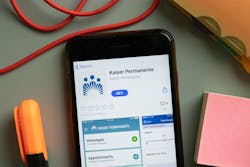Like other large health systems, Kaiser Permanente pivoted rapidly to virtual health offerings to meet patient needs during the pandemic. However, unlike many health systems, KP is maintaining high levels of virtual visits, and expects to continue to do so, says Ramin Davidoff, M.D., executive medical director and chair of the Southern California Permanente Medical Group.
Speaking at the National Primary Care Transformation Summit in the last week of July, Davidoff said that prior to the pandemic approximately 16 percent of KP’s ambulatory visits were done virtually. “As a result of the pandemic and our pivot toward virtual offerings —video and audio — we have been able to increase our telehealth offerings, and currently about 38 percent of all of our ambulatory visits are being done through telehealth, and this is something that we are going to maintain,” he added. “I believe the national average is more in the 16 to 18 percent range. We really believe that the telehealth pivot and the learnings that we had from the pandemic have taught us that the venues of care probably have changed forever in healthcare. And I believe that we need to be able to tap these venues of care to provide safe and effective high-quality care in an affordable manner, and, in fact, use it to improve how we reach many segments of our demographics where perhaps in the past, we weren't able to reach and that will help us in in a very significant way, reduce certain level of healthcare disparities.”
In, 2021, Davidoff, a urologist, was named executive medical director and chair of the board for the Southern California Permanente Medical Group. In addition, Davidoff, is co-CEO of The Permanente Federation, a consortium of all the Permanente Medical Groups in the nation, supporting the work of nearly 23,000 Permanente physicians in the eight Kaiser Permanente regions.
Proactive care
In speaking about primary care transformation, Davidoff said a focus on proactive care is critically important. “Technology will also allow our physicians and nurses to reach and treat patients and engage them more proactively, no matter where they are, and to improve the quality of the care,” he said. The proactive office encounter is something that we've put into place, and it's really centered around our commitment to our primary care physicians to proactively and effectively address patient care gaps.”
Davidoff said that includes issues around breast cancer screening, cervical cancer screening, controlling high blood pressure, comprehensive diabetes care, as well as blood sugar and blood pressure control and retinal eye examinations. Alerts fire every time the patient has a face-to-face or a virtual encounter. That alerts the healthcare team in a team-based approach to address proactively some of these care gaps. “I believe that this has led to improved care in diabetes and hypertension control, as well as in identifying and screening for many of our cancers that we deal with across the organization. So the proactivity of the organization, again, with the commitment to our primary care colleagues, to be the foundation of total health, and the specialists all leaning in to address these care gaps has been an innovation that I believe is really leading to better outcomes for our patients.”
Digital front door
Davidoff said that in Southern California, Kaiser has developed a new united front door that they call the regional virtual medical center. “This allows for more robust digital and telephonic clinical navigation throughout our healthcare delivery system. In 2018, we used to have 400 different phone numbers that we would give out to people to call for appointments, to reach our clinicians and to get care,” he said. “We have 13 contact centers with 13 different hours of operation. Now with the new regional virtual medical center, we've created a single united platform that allows our patients to get their needs met 24/7, and they are able to reach it through our website or single phone number, and the patient may gain access and entry into the system for everything they need, include pharmacy.”
The regional virtual medical center includes a group of doctors, adult primary care physicians, pediatricians, and even hospitalists who can help take care of patients as appropriate across Southern California, or to direct them to the appropriate specialist. “In relation to the COVID experience, this central system played a huge role in supporting our physicians and our system,” he said. “At the height of the pandemic, many of our workflows and our programs really went through this regional central hub, and we were able to meet patient needs and address the issues that clinicians were dealing with.”
Care at home
Davidoff said Kaiser Permanente envisions more and more of acute care will need to be handled outside of a hospital setting. “We have a Kaiser Permanente Care at Home program, which allows for those gray areas between care in the clinic and the acute setting to be managed, and, in fact, much of the acute care to also be managed through this KP Care at Home program.”
He said KP is co-developing remote monitoring tools to be able to handle this. Patients are provided with Bluetooth-enabled kits that include a pulse oximeter, blood pressure cuffs, weight scales, especially for congestive heart failure patients, and a thermometer. “Since January of 2020, we have enrolled approximately 3,700 advanced medical care at home patients and we've had that many admissions with an average daily sense of about 20 as of June of 2022. It is a very important program for us. We are planning to build on it even more. And we have seen benefits already, such as fewer days in the hospital and fewer infections. And there is very high patient satisfaction as we measure internally with these acute care at home programs.”


